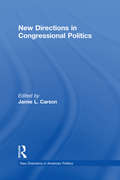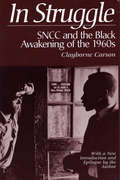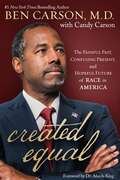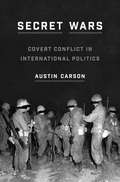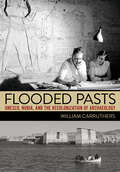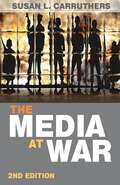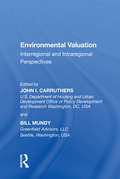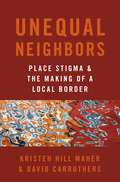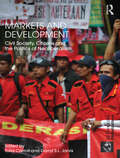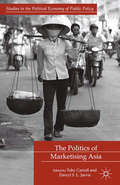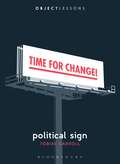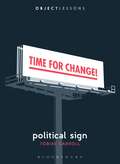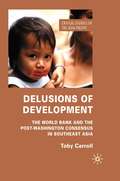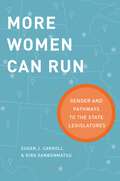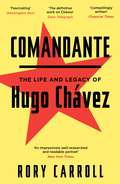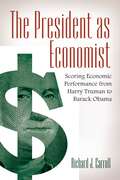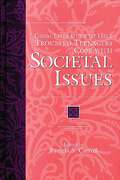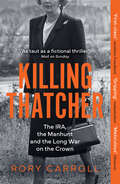- Table View
- List View
New Directions in Congressional Politics
by Jamie L. CarsonAs the U.S. Congress has steadily evolved, so too has our understanding of the institution. New Directions in Congressional Politics offers an accessible overview of the current developments in our understanding of America’s legislative branch. Jamie L. Carson helps students bridge the gap between roles, rules, and outcomes by focusing on four themes woven throughout: the importance of electoral considerations, legislators’ strategic behavior to accomplish objectives, the unique challenges of Congress as a bicameral institution, and the often-overlooked policy outputs of the institution. This book brings together leading scholars of Congress to provide a general overview of the entire field. Each chapter covers the cutting edge developments on its respective topic. As the political institution responsible for enacting laws, the American public regularly looks to the U.S. Congress to address the important issues of the day. The contributors in this volume help explain why staying atop the research trends help us better understand these issues.
Challenging Malaria: The Private and Social Incentives of Mosquito Control
by Byron B. Carson, IIIFive years after Ronald Ross discovered the link between malaria and mosquitos, American entomologist Leland Howard wrote of the "mosquito evil" that occurs when "everybody's business is nobody's business." Howard’s insight was largely ignored, but it captures what social scientists now refer to as the problem of collective action. When this problem persists in the context of malaria, individuals under-provide prevention and suffer from a higher prevalence of malaria. Imagine a group of people trying to drain a pond where mosquitoes breed. Everyone in the group faces an incentive to free ride, which can hinder their drainage efforts. Thus, when people fail to resolve issues related to collective action, they submit to the "mosquito evil" and, potentially, to malaria. This book explores Howard’s logic, the economics of collective action, and the history, epidemiology, and public health of malaria to analyze the conditions under which people privately resolve collective action problems associated with mosquito abatement and malaria prevention. Generally, people are more likely to resolve these problems when the benefits of abatement and prevention outweigh the costs. This logic is developed into a framework and applied to historical and modern-day issues related to malaria, including the lack or abundance of private prevention in the United States and in developing areas; malaria’s resurgence in countries like China, Venezuela, and Bangladesh; and the difficulties of large-scale insecticide-treated bed net campaigns. Given this framework, we should develop a greater appreciation for entrepreneurial responses, civil society, market processes, and private forms of collective action.
In Struggle: SNCC and the Black Awakening of the 1960s, With a New Introduction and Epilogue by the Author (Civil Rights And The Struggle For Black Equality In The Twentieth Century Ser.)
by Clayborne CarsonWith its radical ideology and effective tactics, the Student Nonviolent Coordinating Committee (SNCC) was the cutting edge of the civil rights movement during the 1960s. This sympathetic yet evenhanded book records for the first time the complete story of SNCC’s evolution, of its successes and its difficulties in the ongoing struggle to end white oppression. At its birth, SNCC was composed of black college students who shared an ideology of moral radicalism. This ideology, with its emphasis on nonviolence, challenged Southern segregation. SNCC students were the earliest civil rights fighters of the Second Reconstruction. They conducted sit-ins at lunch counters, spearheaded the freedom rides, and organized voter registration, which shook white complacency and awakened black political consciousness. In the process, Clayborne Carson shows, SNCC changed from a group that endorsed white middle-class values to one that questioned the basic assumptions of liberal ideology and raised the fist for black power. Indeed, SNCC’s radical and penetrating analysis of the American power structure reached beyond the black community to help spark wider social protests of the 1960s, such as the anti–Vietnam War movement. Carson’s history of SNCC goes behind the scene to determine why the group’s ideological evolution was accompanied by bitter power struggles within the organization. Using interviews, transcripts of meetings, unpublished position papers, and recently released FBI documents, he reveals how a radical group is subject to enormous, often divisive pressures as it fights the difficult battle for social change.
Created Equal: The Painful Past, Confusing Present, and Hopeful Future of Race in America
by Ben CarsonIn this inspiring New York Times bestseller, conservative icon Dr. Ben Carson lays out a hopeful road map for how America can come together. External physical characteristics that are genetically encoded are things over which no individual has control. But rather than appreciating the gift of diversity, some have chosen to use it to drive wedges between groups of people. Some of these external characteristics are associated with the past moral failing of slavery. Though slavery in America formally ended in the 1860s, the vestiges of that evil institution are still with us today, and those vestiges often inflict guilt on some and facilitate feelings of victimhood in others. In Created Equal, Dr. Carson uses his own personal experiences as a member of a racial minority, along with the writings and experiences of others from multiple backgrounds and demographics, to analyze the current state of race relations in America. Instead of using race as an excuse to remake America into something completely antithetical to the Constitution, Dr. Carson suggests ways to enhance and bring great success to our nation and all multiethnic societies by magnifying America's incredible strengths instead of her historical weaknesses.
Secret Wars: Covert Conflict in International Politics (Princeton Studies in International History and Politics #157)
by Austin CarsonSecret Wars is the first book to systematically analyze the ways powerful states covertly participate in foreign wars, showing a recurring pattern of such behavior stretching from World War I to U.S.-occupied Iraq. Investigating what governments keep secret during wars and why, Austin Carson argues that leaders maintain the secrecy of state involvement as a response to the persistent concern of limiting war. Keeping interventions “backstage” helps control escalation dynamics, insulating leaders from domestic pressures while communicating their interest in keeping a war contained.Carson shows that covert interventions can help control escalation, but they are almost always detected by other major powers. However, the shared value of limiting war can lead adversaries to keep secret the interventions they detect, as when American leaders concealed clashes with Soviet pilots during the Korean War. Escalation concerns can also cause leaders to ignore covert interventions that have become an open secret. From Nazi Germany’s role in the Spanish Civil War to American covert operations during the Vietnam War, Carson presents new insights about some of the most influential conflicts of the twentieth century.Parting the curtain on the secret side of modern war, Secret Wars provides important lessons about how rival state powers collude and compete, and the ways in which they avoid outright military confrontations.
Secret Wars: Covert Conflict in International Politics (Princeton Studies in International History and Politics #157)
by Austin CarsonSecret Wars is the first book to systematically analyze the ways powerful states covertly participate in foreign wars, showing a recurring pattern of such behavior stretching from World War I to U.S.-occupied Iraq. Investigating what governments keep secret during wars and why, Austin Carson argues that leaders maintain the secrecy of state involvement as a response to the persistent concern of limiting war. Keeping interventions “backstage” helps control escalation dynamics, insulating leaders from domestic pressures while communicating their interest in keeping a war contained.Carson shows that covert interventions can help control escalation, but they are almost always detected by other major powers. However, the shared value of limiting war can lead adversaries to keep secret the interventions they detect, as when American leaders concealed clashes with Soviet pilots during the Korean War. Escalation concerns can also cause leaders to ignore covert interventions that have become an open secret. From Nazi Germany’s role in the Spanish Civil War to American covert operations during the Vietnam War, Carson presents new insights about some of the most influential conflicts of the twentieth century.Parting the curtain on the secret side of modern war, Secret Wars provides important lessons about how rival state powers collude and compete, and the ways in which they avoid outright military confrontations.
Flooded Pasts: UNESCO, Nubia, and the Recolonization of Archaeology
by William CarruthersFlooded Pasts examines a world famous yet critically underexamined event—UNESCO's International Campaign to Save the Monuments of Nubia (1960–80)—to show how the project, its genealogy, and its aftermath not only propelled archaeology into the postwar world but also helped to "recolonize" it. In this book, William Carruthers asks how postwar decolonization took shape and what role a colonial discipline like archaeology—forged in the crucible of imperialism—played as the "new nations" asserted themselves in the face of the global Cold War.As the Aswan High Dam became the centerpiece of Gamal Abdel Nasser's Egyptian revolution, the Nubian campaign sought to salvage and preserve ancient temples and archaeological sites from the new barrage's floodwaters. Conducted in the neighboring regions of Egyptian and Sudanese Nubia, the project built on years of Nubian archaeological work conducted under British occupation and influence. During that process, the campaign drew on the scientific racism that guided those earlier surveys, helping to consign Nubians themselves to state-led resettlement and modernization programs, even as UNESCO created a picturesque archaeological landscape fit for global media and tourist consumption. Flooded Pasts describes how colonial archaeological and anthropological practices—and particularly their archival and documentary manifestations—created an ancient Nubia severed from the region's population. As a result, the Nubian campaign not only became fundamental to the creation of UNESCO's 1972 World Heritage Convention but also exposed questions about the goals of archaeology and heritage and whether the colonial origins of these fields will ever be overcome.
The Media at War
by Susan L. CarruthersNews media, movies, blogs and video games issue constant invitations to picture war, experience the thrill of combat, and revisit battles past. War, it's often said, sells. But what does it take to sell a war, and to what extent can news media be viewed as disinterested reporters of truth?Lively and highly readable, this book explores how wars have been reported, interpreted and perpetuated from the dawn of the media age to the present digital era. Spanning a broad geographical and historical canvas, Susan L. Carruthers provides a compelling analysis of the forces that shape the production of news and images of war – from state censorship to more subtle forms of military manipulation and popular pressure. This fully revised second edition has been updated to cover modern-day conflict in the post 9/11 epoch, including the wars in Iraq and Afghanistan. Rich in historical detail, The Media at War also provides sharp insights into contemporary experience, prompting critical reflection on western society's paradoxical attitudes towards war.
Environmental Valuation: Interregional and Intraregional Perspectives
by John. I. Carruthers Bill MundyEnvironmental quality is one of the most important issues faced by contemporary urban and regional policy. Amenities such as access to the natural environment, attractive neighbourhood characteristics and high quality public goods and services, play a direct role in determining where people choose to live and how much they are willing to do so. Likewise, negative environmental conditions, such as contamination, influence the real estate markets and the 'value' of a region. Increasingly, regions become winners or losers based on the quality of life they offer their inhabitants. Bringing together a team of leading scholars, this book addresses the issues of environmental valuation, answering questions such as: What kinds of features matter? How large of an affect do they have? How do they affect the spatial distribution of the population? And how should the value that people place on their environment affect urban and regional policy?
Environmental Valuation: Interregional and Intraregional Perspectives
by John. I. Carruthers Bill MundyEnvironmental quality is one of the most important issues faced by contemporary urban and regional policy. Amenities such as access to the natural environment, attractive neighbourhood characteristics and high quality public goods and services, play a direct role in determining where people choose to live and how much they are willing to do so. Likewise, negative environmental conditions, such as contamination, influence the real estate markets and the 'value' of a region. Increasingly, regions become winners or losers based on the quality of life they offer their inhabitants. Bringing together a team of leading scholars, this book addresses the issues of environmental valuation, answering questions such as: What kinds of features matter? How large of an affect do they have? How do they affect the spatial distribution of the population? And how should the value that people place on their environment affect urban and regional policy?
Unequal Neighbors: Place Stigma and the Making of a Local Border
by David Carruthers Kristen Hill MaherSan Diego and Tijuana are the site of a national border enforcement spectacle, but they are also neighboring cities with deeply intertwined histories, cultures, and economies. In Unequal Neighbors, Kristen Hill Maher and David Carruthers shift attention from the national border to a local one, examining the role of place stigma in reinforcing actual and imagined inequalities between these cities. Widespread "bordered imaginaries" in San Diego represent it as a place of economic vitality, safety, and order, while stigmatizing Tijuana as a zone of poverty, crime, and corruption. These dualisms misrepresent complex realities on the ground, but they also have real material effects: the vision of a local border benefits some actors in the region while undermining others. Based on a wide range of original empirical materials, the book examines how asymmetries between these cities have been produced and reinforced through stigmatizing representations of Tijuana in media, everyday talk, economic relations, and local tourism discourse and practices. However, both place stigma and borders are subject to contestation, and the book also examines "debordering" practices and counter-narratives about Tijuana's image. While the details of the book are particular to this corner of the world, the kinds of processes it documents offer a window into the making of unequal neighbors more broadly. The dynamics at the Tijuana border present a framework for understanding how inequalities that manifest in cultural practices produce asymmetric borders between places.
Expose, Oppose, Propose: Alternative Policy Groups and the Struggle for Global Justice
by William K. CarrollNeoliberal capitalism positions us all as consumers in a hypermarket where money talks. For the majority of people around the globe, this translates as precarity and immiseration. But how can we break from this dominant ideological framework?Expose, Oppose, Propose details how, since the mid 1970s, transnational alternative policy groups (TAPGs) have functioned as think tanks of a different sort, generating resources for a globalization from below in dialogue with the critical social movements that are protagonists for global justice.Based on two years of intensive research, William Carroll not only provides a detailed examination of a variety of TAPGs – showing how each group is distinctive and autonomous in its vision, practical priorities, and ways of producing and mobilizing alternative knowledge – but also reveals how TAPGs form a master frame that advocates and envisages global justice and ecological wellbeing.
Expose, Oppose, Propose: Alternative Policy Groups and the Struggle for Global Justice
by William K. CarrollNeoliberal capitalism positions us all as consumers in a hypermarket where money talks. For the majority of people around the globe, this translates as precarity and immiseration. But how can we break from this dominant ideological framework?Expose, Oppose, Propose details how, since the mid 1970s, transnational alternative policy groups (TAPGs) have functioned as think tanks of a different sort, generating resources for a globalization from below in dialogue with the critical social movements that are protagonists for global justice.Based on two years of intensive research, William Carroll not only provides a detailed examination of a variety of TAPGs – showing how each group is distinctive and autonomous in its vision, practical priorities, and ways of producing and mobilizing alternative knowledge – but also reveals how TAPGs form a master frame that advocates and envisages global justice and ecological wellbeing.
Markets and Development: Civil Society, Citizens and the Politics of Neoliberalism (ISSN)
by Toby Carroll Darryl JarvisMarkets and Development presents a series of critical contributions focused on the political relationship between citizens, civil society, and neoliberal development policy’s latest form. The dramatic increase of ‘access to finance’ investments, newly gender-sensitive approaches to building neoliberal labour markets, the universal promotion of public-private partnerships, and the ‘development financing’ of extractive industries, have all seen citizens, social movements, and NGOs variously engaged in, and against, neoliberalism like never before. The precise form that this engagement takes is conditioned by both the perceived and real opportunities, and the risks, of an agenda which seeks to intern ‘emerging’ and ‘frontier markets’ deep within a concretising world market, with transformative repercussions for both those involved and, notably, for state-society relations. The contributors to this volume focus on essential aspects of the contemporary neoliberal development agenda and its relationship to and with citizens and civil society, tackling questions related to the roles that various actors within civil society in the underdeveloped world are playing under late capitalism, and how these roles relate to current efforts to establish and extend markets, and market society more broadly, in a neoliberal image. This book was originally published as a special issue of Globalizations.
The Politics of Marketising Asia (Studies in the Political Economy of Public Policy)
by Toby Carroll Darryl S.l. JarvisEconomic growth continues to transform the economic and political landscape of Asia. Equally the policies now being adopted to promote private sector participation, re-structure state entities, and reduce the presence of the state in the provision of public goods and services, are tied to fundamental transformations in Asia's state-society relations. The global cast of contributors present a timely analysis of the impact of neo-liberalism on Asia's developmental policies and the organisation of Asian states and markets. Ironically, the "developmental state" that has historically driven Asia's rapid economic transformation is now threatened by an increasingly dominant neoliberal agenda that aims to roll back the state in the name of market fundamentalism.
Political Sign (Object Lessons)
by Tobias CarrollObject Lessons is a series of short, beautifully designed books about the hidden lives of ordinary things.In an election year, political signs can be impossible to avoid. They're in front yards, on bumper stickers, and in some places you might never have expected. Tobias Carroll chronicles the permutations and secret histories of political signs, venturing into the story of how they came to be and illuminating how the signs around us shape us in ways we often fail to appreciate. In an era of political polarization and heated debate, what can be learned from studying how our personal space becomes the setting for both? Understanding political signs can help us understand our current political moment, and how we might transcend it.Object Lessons is published in partnership with an essay series in The Atlantic.
Political Sign (Object Lessons)
by Tobias CarrollObject Lessons is a series of short, beautifully designed books about the hidden lives of ordinary things.In an election year, political signs can be impossible to avoid. They're in front yards, on bumper stickers, and in some places you might never have expected. Tobias Carroll chronicles the permutations and secret histories of political signs, venturing into the story of how they came to be and illuminating how the signs around us shape us in ways we often fail to appreciate. In an era of political polarization and heated debate, what can be learned from studying how our personal space becomes the setting for both? Understanding political signs can help us understand our current political moment, and how we might transcend it.Object Lessons is published in partnership with an essay series in The Atlantic.
Delusions of Development: The World Bank and the Post-Washington Consensus in Southeast Asia (Critical Studies of the Asia-Pacific)
by T. CarrollInvestigates the World Bank's promotion of market-led development in the underdeveloped world and the impact that this promotion has upon citizenship. This book looks at this subject using case studies drawn from Southeast Asia, one of the world's most diverse regions.
More Women Can Run: Gender and Pathways to the State Legislatures
by Susan J. Carroll Kira SanbonmatsuWomen remain dramatically underrepresented in elective office, including in entry-level political offices. While they enjoy the freedom to stand for office and therefore have an equal legal footing with men, this persistent gender imbalance raises pressing questions about democratic legitimacy, the inclusivity of American politics, and the quality of political representation. The reasons for women's underrepresentation remain the subject of much debate. One explanation--that the United States lacks sufficient openings for political newcomers--has become less compelling in recent years, as states that have adopted term limits have not seen the expected gains in women's office holding. Other accounts about candidate scarcity, gender inequalities in society, and the lingering effects of gendered socialization have some merit; however, these accounts still fail to explain the relatively low numbers. Drawing upon original surveys conducted in 1981 and 2008 by the Center for American Women and Politics (CAWP) of women state legislators across all fifty states, and follow-up interviews after the 2008 survey, the authors find that gender differences in pathways to the legislatures, first evident in 1981, have been surprisingly persistent over time. They find that, while the ambition framework better explains men's decisions to run for office, a relationally embedded model of candidate emergence better captures women's decision-making, with women's decisions more often influenced by the encouragement and support of parties, organizations, and family members. By rethinking the nature of women's representation, this study calls for a reorientation of academic research on women's election to office and provides insight into new strategies for political practitioners concerned about women's political equality.
Edmund Burke (Classic Thinkers)
by Ross CarrollFew thinkers have provoked such violently opposing reactions as Edmund Burke. A giant of eighteenth-century political and intellectual life, Burke has been praised as a prophet who spied the terror latent in revolutionary or democratic ideologies, and condemned as defender of social hierarchy and outmoded political institutions. Ross Carroll tempers these judgments by situating Burke’s arguments in relation to the political controversies of his day. Burke’s writings must be understood as rhetorically brilliant exercises in political persuasion aimed less at defending abstract truths than at warning his contemporaries about the corrosive forces – ideological, social, and political – that threatened their society. Drawing on Burke’s enormous corpus, Carroll presents a nuanced portrait of Burke as, above all, a diagnostician of political misrule, whether domestic, foreign, or imperial. Burke’s lasting value, Carroll argues, derives less from the content of his specific positions than from the difficult questions he forces us to ask of ourselves. This engaging and illuminating account of Burke’s work is a vital reference for students and scholars of history, philosophy, and political thought.
Comandante: Inside Hugo Chavez's Venezuela
by Rory CarrollUpdated since the death of Hugo Chávez in March 2013, Comandante is the definitive account of Chávez's presidency, and the legacy he has left behind. Hugo Chávez was a true phenomenon. On his death in March 2013 tens of thousands of Venezuelans took to the streets and honoured a seven-day period of national mourning. Chávez has been compared to Napoleon, Nasser, Perón and Castro but the truth is there has never been a leader like him. He was democratically elected, reigned like a monarch from a mobile television throne, and provoked adoration and revulsion in equal measure. How did a charismatic autocrat seduce not just a nation but a significant part of world opinion? And how did he continue to stay in power despite the crumbling of Venezuela? When he first came to power in 1999, Chávez became a symbol of hope and freedom for his people. Yet, in his fourteen years as president, Chávez seized control of the lucrative Venezuelan oil industry, allowed basic government functions to wither, jailed political opponents and courted Castro and Ahmadinejad, all while occupying much of Venezuela's airwaves with his long-running television show, Aló Presidente!. In Comandante, acclaimed journalist Rory Carroll breaches the walls of Miraflores Palace to tell the inside story of Chávez's life and his political court in Caracas. Blending the lyricism and strangeness of magical realism with the brutal, ugly truth of authoritarianism - a powerful combination reminiscent of Ryszard Kapuscinski's The Emperor - Rory Carroll has written the definitive account of Hugo Chávez's presidency, and the legacy he has left behind.
The President as Economist: Scoring Economic Performance from Harry Truman to Barack Obama
by Richard J. CarrollThis book provides evaluations of American presidents over the course of 66 years of U.S. economic history, using quantitative data to provide credible, defensible answers to controversial questions like "Whose economic policies were more effective, Ronald Reagan's or Bill Clinton's?"The President as Economist: Scoring Economic Performance from Harry Truman to Barack Obama provides eye-opening insights about matters of critical importance for the future of the United States. Author Richard J. Carroll tackles a topic that he has researched and been focused on for more than 20 years, providing impartial assessments and rankings of each presidential administration according to numerous key performance indicators—quantitative data, not subjective opinions. The final chapter combines all of the data to present a numeric score (Presidential Performance Index-PPI) for each administration that allows an overall ranking of the 11 presidents. The analysis covers 66 years of U.S. economic history, ranging from 1946 through 2011. The earlier administrations of Harry S. Truman through Jimmy Carter set the context against which more recent presidencies are judged. This title will be an invaluable resource for everyone from general readers to students at the high school, undergraduate, and graduate levels, as well as journalists, lobbyists, and anyone directly or indirectly involved in the political process.
The President as Economist: Scoring Economic Performance from Harry Truman to Barack Obama
by Richard J. CarrollThis book provides evaluations of American presidents over the course of 66 years of U.S. economic history, using quantitative data to provide credible, defensible answers to controversial questions like "Whose economic policies were more effective, Ronald Reagan's or Bill Clinton's?"The President as Economist: Scoring Economic Performance from Harry Truman to Barack Obama provides eye-opening insights about matters of critical importance for the future of the United States. Author Richard J. Carroll tackles a topic that he has researched and been focused on for more than 20 years, providing impartial assessments and rankings of each presidential administration according to numerous key performance indicators—quantitative data, not subjective opinions. The final chapter combines all of the data to present a numeric score (Presidential Performance Index-PPI) for each administration that allows an overall ranking of the 11 presidents. The analysis covers 66 years of U.S. economic history, ranging from 1946 through 2011. The earlier administrations of Harry S. Truman through Jimmy Carter set the context against which more recent presidencies are judged. This title will be an invaluable resource for everyone from general readers to students at the high school, undergraduate, and graduate levels, as well as journalists, lobbyists, and anyone directly or indirectly involved in the political process.
Using Literature to Help Troubled Teenagers Cope with Societal Issues (The Greenwood Press Using Literature to Help Troubled Teenagers Series)
by Pamela Sissi CarrollTeachers, media specialists, parents, and other adults who work with adolescents must recognize that our society influences who teenagers are and how they develop as language users. This unique resource provides guidance to these professionals by pairing literacy specialists with counselors who introduce information about social issues important to today's adolescents. These experts then explore literature in which issues such as: body image, sexuality, and leaving home are addressed in ways likely to interest teens. By examining fictional characters, these experts provide guidance to those working with teenagers, so they can encourage adolescents to deal with the conflicts and issues imposed upon them by our society while improving their reading and writing skills.Eight important social issues are explored each in a separate chapter. While providing in-depth exploration of fictional characters grappling with these societal issues, each chapter also provides a question and answer section in which specialists answer questions many adults have raised regarding social influences on teenagers. Readers are given insight into how they can help teenagers with similar problems, and extensive annotated bibliographies recommend appropriate books to get teenagers reading and addressing these problems. This collaboration across academic specialties provides an innovative approach to attaining the goal of helping adults and adolescents in gaining a better understanding of each other.
Killing Thatcher: The IRA, the Manhunt and the Long War on the Crown
by null Rory CarrollA Sunday Times History Book of the Year 2023 A Spectator Book of the Year 2023 The Irish Times No.1 Bestseller ‘As taut as a fictional thriller’ Mail on Sunday ‘Gripping, detailed and richly layered’ Guardian KILLING THATCHER is the gripping account of how the IRA came astonishingly close to killing Margaret Thatcher and to wiping out the British Cabinet – an extraordinary assassination attempt linked to the Northern Ireland Troubles and the most daring conspiracy against the Crown since the Gunpowder Plot. In this fascinating and compelling book, veteran journalist Rory Carroll retraces the road to the infamous Brighton bombing in 1984 – an incident that shaped the political landscape in the UK for decades to come. He begins with the infamous execution of Lord Mountbatten in 1979 – for which the IRA took full responsibility – before tracing the rise of Margaret Thatcher, her response to the ‘Troubles’ in Ireland and the chain of events that culminated in the hunger strikes of 1981 and the death of 10 republican prisoners, including Bobby Sands. From that moment on Thatcher became an enemy of the IRA – and the organisation swore revenge. Opening with a brilliantly-paced prologue that introduces bomber Patrick Magee in the build up to the incident, Carroll sets out to deftly explore the intrigue before and after the assassination attempt – with the story spanning three continents, from pubs and palaces, safe houses and interrogation rooms, hotels and barracks. On one side, an elite IRA team aided by a renegade priest, US-raised funds and Libya’s Qaddafi and on the other, intelligence officers, police detectives, informers and bomb disposal officers. An exciting narrative that blends true crime with political history, this is the first major book to investigate the Brighton attack.
